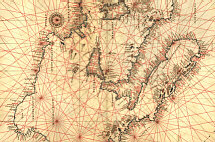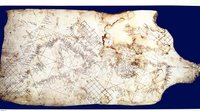 The Tunisian coasts in Agnese's Atlas (1514-65)
The Tunisian coasts in Agnese's Atlas (1514-65)(Library of Congress)
Saudi Aramco World has published recently a special issue (July/August) that provides a nice straightforward introduction to non-specialists to the history of Islamic navigation.
http://www.saudiaramcoworld.com/issue/200504/Ibn Majid obviously is the usual star.
Still some basic questions should have been asked by the author (Paul Lunde): Ibn Majid is known by his writings... No indications has remained pointing to him as a cartographer except for his vague notes on "32 rhumbs": how can he write portolans-like texts (navigational guides) without seeing the need of making a visual presentation of his guides as was the case for the Mediterranean navigators (like Agnese's maps shown above)? Certainly it's still diffcilt to answer this question but it was worth to throw it out...
The most interesting text of the whole issue I think is the small and simple explanation of the Muslims' need, including the navigators, of a solar calendar rather than the Islamic/Hijri lunar calendar:
"The Calendar of Yazdagird and the Rasulid Almanac
A solar calendar was as necessary for navigation as it was for agriculture. The Islamic lunar calendar could not be used, because there was no correlation between the months and the seasons. In Yemen, the Roman Julian calendar was used for agriculture, and a particular form of the Persian calendar was used as a navigational calendar. It was called the Calendar of Yazdagird, after the last Sasanian monarch, Yazdagird III, who established it in 632. This Persian calendar is of great significance, for it was the calendar used in the Middle Ages by Indian Ocean sailors from the Arabic-speaking world.
Year 1 of Yazdagird’s calendar corresponds to 632, and the first day of the year was the summer solstice, June 16. Although the calendar was divided into 12 months, which were given their Persian names, the days of the year were simply numbered consecutively, 1 to 365. This is how Ahmad ibn Majid uses the system to describe a voyage he made in 1471: “We set sail on day 135, only reaching Jiddah after a difficult voyage. We sighted Ra’s Hafun on day 175 and entered the Bab al-Mandab on day 200 against strong northerlies….”
The earliest evidence for the existence of this navigational calendar is an almanac composed in 1271 by the Rasulid sultan of Yemen, al-Malik al-Ashraf. The almanac is based on much older sources, most probably originating in the Gulf port of Siraf, the crucible of early Islamic Indian Ocean navigation. Siraf was destroyed by an earthquake in 977, and the wealthy merchants, shipowners and navigators of the port emigrated, spreading out along the South Arabian, Red Sea and East African coasts. They took with them their capital, their know-how and their networks of international contacts. This diaspora from Siraf had much to do with the growth of ports like Jiddah and Aden. In East Africa it laid the foundations for what became the ports of Mogadishu, Kilwa and Malindi.
The almanac is a perfect example of how the diverse strands of learning that make up classical Islamic civilization were woven into a coherent whole: Month names are in Syriac, derived from Old Babylonian; to these are added Persian month names from the calendar of Yazdagird. The equinoxes and solstices are marked, and the rising and setting of prominent stars and the anwa—constellations whose appearance at dawn heralded rain—are given according to the old Bedouin system. Measurements of shadow lengths throughout the year are included. The days are marked to allow correlation with the Roman Julian calendar. And there is useful information on times to sow and reap, on insect pests, healthy and unhealthy seasons and much more.
The almanac also includes the dates of departure and arrival of ships from India, Qalhat, Hormuz, al-Shihr, Mogadishu and Egypt. This flagging of dates significant to both farmers and mariners shows how the prosperity of the Rasulid dynasty was based on both agriculture and trade.
The entries in the almanac reveal a highly synchronized system of regular shipping among Aden, East Africa and Egypt. The end of the southwest monsoon came with the spring equinox, on Day 65; the entry for Day 68 (March 16) reads, “End of sailing of Indian ships from India to Aden; no one ventures out after this day.” On Day 100 (April 15), the last fleet from India was scheduled to arrive; the arrival of the first ships of the convoy from Egypt, the karim, was timed to coincide with this. The last ships from Egypt arrived on Day 220 (August 14). Six days later, ships from Sri Lanka and Coromandel set out on their voyages home. The last sailing out of Aden on the India run during the northeast monsoon was on Day 250 (September 13). And in addition to these major convoys, there were the ships from the Gulf and East Africa—interregional trade that was also tied in with the oceangoing merchant convoys."






